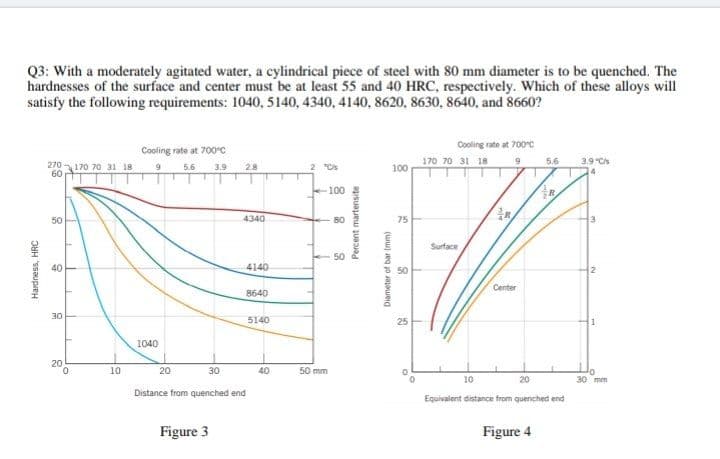Q3: With a moderately agitated water, a cylindrical piece of steel with 80 mm diameter is to be quenched. The hardnesses of the surface and center must be at least 55 and 40 HRC, respectively. Which of these alloys will satisfy the following requirements: 1040, 5140, 4340, 4140, 8620, 8630, 8640, and 8660? Cooling rate at 700C Cooling rate at 700c 170 70 31 18 9 5.6 270170 70 31 18 9 60 3.9 C 5.6 3.9 28 100 100 50 4340 Surface 40 4140 50 Center 8640 30 5140 1040 20 10 20 30 40 50 mm 10 20 30 mm Distance from quenched end Equivalent distance from quenched end Figure 3 Figure 4 Hardness, HRC Percent martensite Diameter of bar lmm) 75
Q3: With a moderately agitated water, a cylindrical piece of steel with 80 mm diameter is to be quenched. The hardnesses of the surface and center must be at least 55 and 40 HRC, respectively. Which of these alloys will satisfy the following requirements: 1040, 5140, 4340, 4140, 8620, 8630, 8640, and 8660? Cooling rate at 700C Cooling rate at 700c 170 70 31 18 9 5.6 270170 70 31 18 9 60 3.9 C 5.6 3.9 28 100 100 50 4340 Surface 40 4140 50 Center 8640 30 5140 1040 20 10 20 30 40 50 mm 10 20 30 mm Distance from quenched end Equivalent distance from quenched end Figure 3 Figure 4 Hardness, HRC Percent martensite Diameter of bar lmm) 75
Elements Of Electromagnetics
7th Edition
ISBN:9780190698614
Author:Sadiku, Matthew N. O.
Publisher:Sadiku, Matthew N. O.
ChapterMA: Math Assessment
Section: Chapter Questions
Problem 1.1MA
Related questions
Question

Transcribed Image Text:Q3: With a moderately agitated water, a cylindrical piece of steel with 80 mm diameter is to be quenched. The
hardnesses of the surface and center must be at least 55 and 40 HRC, respectively. Which of these alloys will
satisfy the following requirements: 1040, 5140, 4340, 4140, 8620, 8630, 8640, and 8660?
Cooling rate at 700c
Cooling rate at 700°c
170 70 31 18
5.6
3.9 "C
270 170 70 31 18 9
60
2 "Os
5.6
3.9
2.8
100
100
50
4340
80
75
3
Surface
40
4140
Center
8640
30
5140
25
1040
20
10
20
30
40
50 mm
10
20
30 mm
Distance from quenched end
Equivalent distance from quenched end
Figure 3
Figure 4
Hardness, HRC
Percent martensite
Diameter of bar (mm)
Expert Solution
This question has been solved!
Explore an expertly crafted, step-by-step solution for a thorough understanding of key concepts.
This is a popular solution!
Trending now
This is a popular solution!
Step by step
Solved in 2 steps

Knowledge Booster
Learn more about
Need a deep-dive on the concept behind this application? Look no further. Learn more about this topic, mechanical-engineering and related others by exploring similar questions and additional content below.Recommended textbooks for you

Elements Of Electromagnetics
Mechanical Engineering
ISBN:
9780190698614
Author:
Sadiku, Matthew N. O.
Publisher:
Oxford University Press

Mechanics of Materials (10th Edition)
Mechanical Engineering
ISBN:
9780134319650
Author:
Russell C. Hibbeler
Publisher:
PEARSON

Thermodynamics: An Engineering Approach
Mechanical Engineering
ISBN:
9781259822674
Author:
Yunus A. Cengel Dr., Michael A. Boles
Publisher:
McGraw-Hill Education

Elements Of Electromagnetics
Mechanical Engineering
ISBN:
9780190698614
Author:
Sadiku, Matthew N. O.
Publisher:
Oxford University Press

Mechanics of Materials (10th Edition)
Mechanical Engineering
ISBN:
9780134319650
Author:
Russell C. Hibbeler
Publisher:
PEARSON

Thermodynamics: An Engineering Approach
Mechanical Engineering
ISBN:
9781259822674
Author:
Yunus A. Cengel Dr., Michael A. Boles
Publisher:
McGraw-Hill Education

Control Systems Engineering
Mechanical Engineering
ISBN:
9781118170519
Author:
Norman S. Nise
Publisher:
WILEY

Mechanics of Materials (MindTap Course List)
Mechanical Engineering
ISBN:
9781337093347
Author:
Barry J. Goodno, James M. Gere
Publisher:
Cengage Learning

Engineering Mechanics: Statics
Mechanical Engineering
ISBN:
9781118807330
Author:
James L. Meriam, L. G. Kraige, J. N. Bolton
Publisher:
WILEY